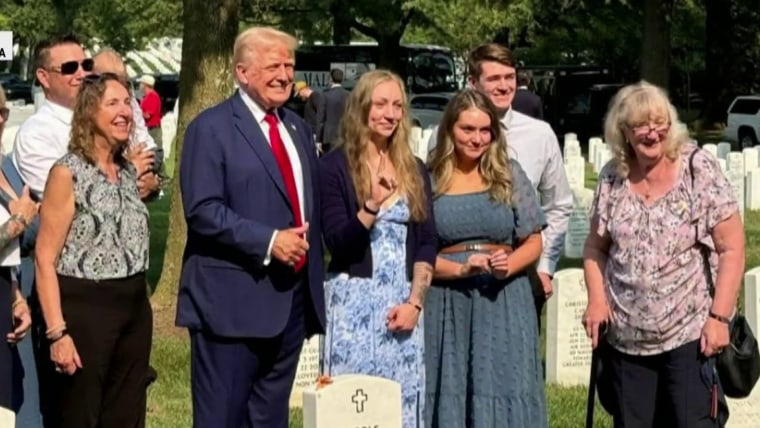I last visited Arlington National Cemetery on Aug. 23, 2022, for the interment of my grandfather. Eighty years earlier, he’d gotten his first taste of combat as a line officer at the Battle of Midway. We were there to bury him in Section 31, alongside my grandmother. The sun was shining, and a bagpiper played “Going Home.” There were no thumbs up from anyone.
When I read the accounts of Donald Trump’s outrageous photo-op at Arlington, and his campaign staff’s altercation with a cemetery employee, I thought of my grandparents and the anger they’d have for a political candidate trampling on their graves for a campaign ad. I also thought of the cemetery employee, who according to The New York Times declined to press charges out of fear of “retaliation from Trump supporters.” (Politico likewise reported that the decision was “due to concern over retaliation.”) That employee’s fear is even more chilling if you consider Arlington’s history.
Trump’s campaign dispelled any doubts about the purpose of the visit when its TikTok account used footage from Arlington in a post.
What would become a national shrine to our country’s military heroes began as the estate of George Washington Parke Custis, the adopted son of the nation’s first president. When he died in 1857, the property passed to his daughter Mary, whose husband was a U.S. Army officer named Robert E. Lee. Four years later, in the early weeks of the Civil War, the Union Army seized the Arlington estate for use as an artillery outpost. By then, Lee was already a Confederate general, stationed well south of Washington, and his wife ordered the people enslaved on the property to pack up the family’s silver and papers before she abandoned the property ahead of Union troops.
By 1864, according to Smithsonian magazine’s Robert M. Poole, Washington’s cemeteries were running out of room for the war dead. Quartermaster General Montgomery Meigs — who had served under Lee before the war but now believed he should be “executed if caught” — suggested Arlington. He oversaw the burial of thousands of soldiers at the estate and continued doing so after the guns fell silent. He did so not just to ease the burden on other cemeteries, but also to make Arlington uninhabitable for the rebels’ most prominent general at war’s end.
Yet, even as Meigs did his part to make sure the Confederacy never rose again, the freedoms and rights Arlington’s dead had fought for were being undermined. Key to this effort was the use of intimidation. Within a year of Lee’s surrender at Appomattox Court House, a group of Tennesseeans founded the Ku Klux Klan. They and other armed whites embarked on a reign of terror throughout the South against Black people and their white allies. “We are intimidated by the whites,” Black residents of Vicksburg, Mississippi, told the state’s governor in 1875, “We will not vote at all, unless there are troops to protect us.”

The troops did not come. After the disputed 1876 presidential election and the subsequent Compromise of 1877, federal troops withdrew from the South entirely. Reconstruction was over, replaced by Jim Crow segregation. Intimidation and retaliation were this toxic stew’s most important ingredients.
Which brings me back to Trump’s visit to Arlington and the subsequent fallout. The Army told NBC News on Thursday that a Trump aide “abruptly pushed aside” a cemetery employee who was trying to enforce the cemetery’s restrictions on photos and videos. But the employee refused to press charges. Military officials told The New York Times, “she feared Mr. Trump’s supporters pursuing retaliation.” If this isn’t intimidation, what is?
It’s a campaign of thugs, led by a thug.
The employee wasn’t acting arbitrarily: As the cemetery noted in a statement, “Federal law prohibits political campaign or election-related activities within Army National Military Cemeteries, to include photographers, content creators or any other persons attending.” And Trump’s campaign dispelled any doubts about the purpose of the visit when its TikTok account used footage from Arlington in a post.
The woman’s fear is entirely reasonable, and not just because an aide to a former president felt emboldened to push her in the first place. Even without her identity being public, Trump campaign's press secretary Steven Cheung accused her of “suffering from a mental health episode.” Trump senior adviser Chris LaCivita, best known for leading the smear of 2004 Democratic nominee John Kerry’s military service, called her a “despicable individual.” And at a Thursday rally, Trump linked the cemetery staff with the prosecutors of the multiple indictments against him — that is, he linked her to people he says have it out for him.
More broadly, intimidation has been an essential feature of Trump’s campaigns. In his first run, he excused and even applauded when his supporters roughed up protesters. His second run culminated in his incitement of the Jan. 6 insurrection. And in his third run, with staffers like LaCivita and Cheung in key positions, he has done nothing but double down. Now he and his campaign are bullying a woman who merely followed the law protecting the country’s war dead from being exploited as campaign props. It’s a campaign of thugs, led by a thug.
The events at Arlington and the way Trump maligned the character of the woman doing her job epitomize one of the key stakes of this election: whether a man who embraces intimidation over law returns to power. Recent decades have seen America tilt away from the idea that “might makes right.” But that principle reigned during much of our country’s history, and defeating Trump is a way to help keep this dangerous idea from roaring back.

